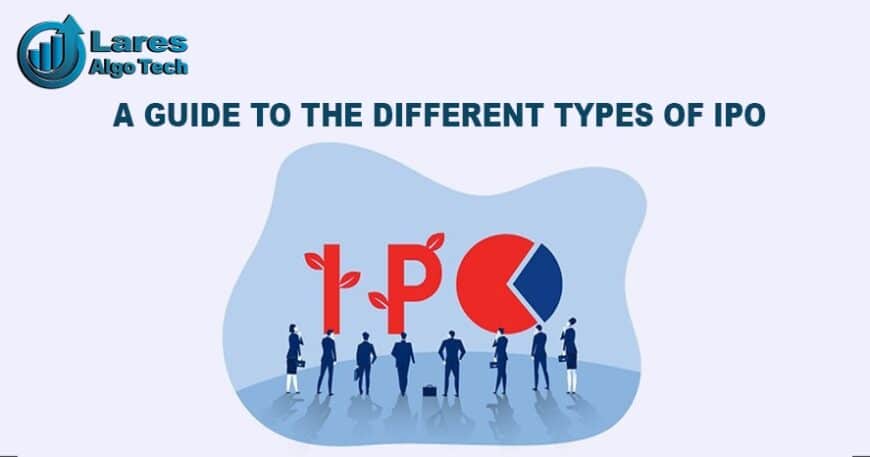An Initial Public Offering (IPO) is the process of selling shares of a private company to the public for the first time. IPOs are a way for companies to raise capital, expand their business, and gain exposure in the market. However, not all IPOs are the same. Different types of IPOs vary in terms of pricing, allocation, and risk. In this blog post, we will explain the main types of IPOs and their advantages and disadvantages for both the company and the investors.
Let’s Understand the Different Types of IPOs
You can easily understand the IPOs before investing your funds. You must know the different types of IPOs below:
Fixed Price IPO
A fixed-price IPO is the most traditional and simple type of IPO. In this type of IPO, the company and its underwriters set a fixed price for the shares before the IPO. The price is determined by analyzing the company’s financials, assets, liabilities, growth prospects, and market conditions. The price is printed in the prospectus, which is a document that provides detailed information about the company and the IPO. The investors can apply for the shares at a fixed price and pay the full amount at the time of application. The demand for the shares is known only after the IPO closes.
Advantages of Fixed Price IPO
- A fixed-price IPO is easy to understand and transparent for investors. They know the exact price and quantity of the shares they are buying.
- A fixed-price IPO can create a positive sentiment for the company if the shares are priced attractively and generate high demand. This can lead to a higher valuation and a successful listing.
Disadvantages of Fixed Price IPO
- A fixed-price IPO can be risky for the company if the shares are too high or too low. If the price is too high, the IPO may not attract enough investors and the shares may remain unsold. If the price is too low, the company may lose out on potential revenue and dilute its ownership more than necessary.
- A fixed-price IPO can be unfair to the investors if the market conditions change after the IPO. The investors may end up paying more or less than the fair value of the shares. They may also face difficulty in selling or buying the shares in the secondary market if the liquidity is low.
Book Building IPO
A book-building IPO is a more modern and flexible type of IPO. In this type of IPO, the company and its underwriters do not set a fixed price for the shares, but a price range or a price band. The price band has a lower limit (floor price) and an upper limit (cap price). The investors can bid for the shares within the price band and specify the quantity and price they are willing to pay. The bids are collected and recorded in a book, which is updated regularly. The final price of the shares is decided after the IPO closes, based on the demand and supply of the shares. The investors pay the final price only after the allocation of the shares.
Advantages of Book Building IPO
- A book-building IPO is more efficient and dynamic for the company. The company can adjust the price band and the size of the IPO according to the market response and investor feedback. The company can also maximize its revenue and minimize its dilution by setting the optimal price for the shares.
- A book-building IPO is more fair and transparent for the investors. The investors can see the demand and supply of the shares and the price discovery process. The investors can also modify or cancel their bids until the IPO closes. The investors pay the same price for the shares regardless of their bid price, as long as it is within the price band.
Disadvantages of Book Building IPO
- A book-building IPO can be complex and confusing for investors. The investors may only know the exact price and quantity of the shares they get once the allocation is done. Investors may also face uncertainty and volatility in the secondary market if the price band is too wide or the demand is too low.
- A book-building IPO can be costly and time-consuming for the company. The company has to incur higher fees and expenses for the underwriters, the book runners, and the intermediaries. The company also has to comply with more regulations and disclosures for the IPO.
Frequently Asked Questions about IPOs in India
1. What is the minimum investment amount required for an IPO in India?
This varies depending on the IPO, but typically it’s around Rs.10,000 to Rs.15,000.
2. What documents do I need to apply for an IPO?
You need a Demat account and a PAN card. Some brokers may require additional documents.
3. How can I apply for an IPO in India?
You can apply through your Demat account online or offline through your broker.
4. Where can I find information about upcoming IPOs in India?
The websites of SEBI (Securities and Exchange Board of India), NSE (National Stock Exchange), and BSE (Bombay Stock Exchange) list upcoming IPOs. Many financial websites and news publications also provide this information.
5. What is the difference between a fixed-price IPO and a book-building IPO in India?
In a fixed-price IPO, the price is set beforehand, while in a book-building IPO, the price is discovered through a bidding process. Fixed-price IPOs are simpler for investors, but book-building IPOs can lead to a more accurate price discovery.
6. Which type of IPO is more common in India?
Book-building IPOs are more common in India than fixed-price IPOs.
7. Which type of IPO is the best for me?
The best type of IPO for you will depend on your risk tolerance, investment goals, and understanding of the market. It’s important to do your research and seek professional advice before investing in any IPO.
Conclusion
IPOs are a popular and lucrative way for companies to raise capital and go public. However, different types of IPOs have different implications for the company and the investors. A fixed-price IPO is simple and transparent, but risky and rigid. A book-building IPO is flexible and efficient, but complex and costly. As an investor, you should understand the pros and cons of each type of IPO and make an informed decision based on your risk appetite, return expectations, and market knowledge.






 .facebook.com/lares.algotech
.facebook.com/lares.algotech  instagram.com/laresalgotech/
instagram.com/laresalgotech/  x.com/AlgoLares
x.com/AlgoLares  whatsapp.com/channel/...
whatsapp.com/channel/...  .linkedin.com/company/lares-algotech/
.linkedin.com/company/lares-algotech/  youtube.com/@LaresAlgoTech
youtube.com/@LaresAlgoTech